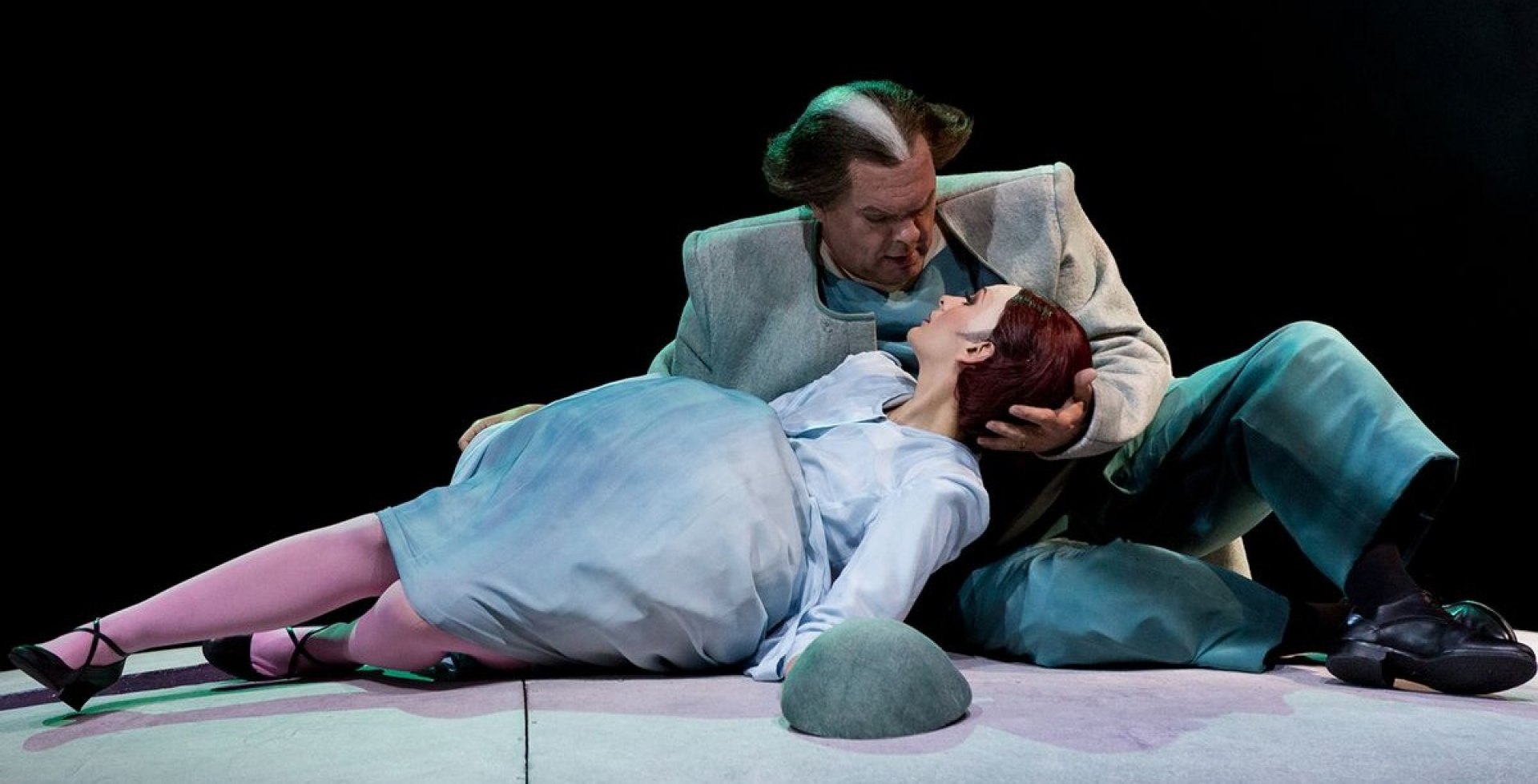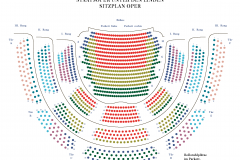Pelléas and Mélisande
Mo | Tu | We | Th | Fr | Sa | Su |
Pelléas and Mélisande
Drame lyrique in five acts (1902)
Music by Claude Debussy
Text by Maurice Maeterlinck
Duration: Approximately 3 hours and 15 minutes, including one intermission after Act III
Language: Performed in French with German and English surtitles
Recommended Age: Suitable for ages 14 and up
With the world premiere of Pelléas et Mélisande in 1902, Claude Debussy challenged his contemporaries to listen to music in a new way. His instrumentation was without precedent. He transposed the Wagnerian leitmotif technique into a subtle tone painting and described atmospheres and dispositions of the soul that elude description and that even music is often only able to gesture towards.
The opera is based on a drama of the same name by the Flemish symbolist Maurice Maeterlinck that tells the tragic, fairytale-like story of a love triangle between the stepbrothers Golaud and Pelléas and the mysterious Mélisande. The plot is sketched in vague terms, with the main emphasis on exploring the depths of the characters’ psyches. The tragedy takes the form not of open conflict but of subliminal mental processes. Debussy’s music remains equally restrained, often approaching silence. Myriad colours shimmer beneath the monochrome surface, however, and Debussy manages to perfectly translate the enigmatic, morbid atmosphere into music. In 1991, Ruth Berghaus, one of the greatest directors of the 20th century, staged Pelléas et Mélisande at the Staatsoper Unter den Linden.
Plot
Act one
Golaud, having wandered astray while hunting, comes upon the mysterious Mélisande. He questions her, but learns only that she has fled the company of mankind. Golaud convinces her to follow him. Geneviève reads King Arkel a letter, which Golaud has written to his brother Pelléas. In the letter, Golaud tells of his marriage to Mélisande, and asks Pelléas to ask Arkel whether he is prepared to honour this stranger as his own daughter. A particular fire signal is to indicate Arkel’s willingness to accept Mélisande, who complains to Geneviève about the gloominess of the park and the castle. Pelléas and Mélisande find the ship that brought Mélisande to this place.
Act two
Mélisande loses the ring she received from Golaud in the fountain. In the instant the ring falls into the fountain, Golaud’s horse rears up. Golaud notices that the ring is missing from Mélisande’s finger, and sends her into the dark night to look for the ring. Pelléas is to accompany her. In a cave, Pelléas and Mélisande discover three sleeping old troglodytes. Mélisande flees in horror.
Act three
Pelléas amuses himself, playing with Mélisande’s hair. Golaud arrives, rebukes their "child’s play", and leads Pelléas to the Cistern of Death, advising his brother to avoid Mélisande in future. Golaud increasingly doubts Mélisande’s faithfulness. After ordering his son Yniold to observe them, he learns that the two have kissed.
Act four
Mélisande promises Pelléas that she will come, when evening falls, to the fountain where she has lost the ring. It is to be their final meeting. Arkel tries to convey to Mélisande his own affection for her. After Golaud humiliates Mélisande, she and Pelléas meet in secret. Golaud, jealous, then murders his brother. Mélisande flees again.
Act five
Mélisande has now given birth to a child, and fallen very ill. Golaud demands to know from her whether her love for Pelléas was unchaste. Mélisande dies. Arkel words of eulogy over her: "Oh, she was such a dear small creature, so timid, so quiet and so tender. Yes, this poor small creature was full of mystery, as are we all …".
Program and cast
Musical Director: François-Xavier Roth
Director: Ruth Berghaus
Set Design, Costumes: Hartmut Meyer
Chorus Master: Christian Jost
Arkel: Stephen Milling
Geneviève: Anne Sofie von Otter
Pelléas: Gyula Orendt
Golaud: Simon Keenlyside
Mélisande: Magdalena Kožená
Yniold: Solist des Tölzer Knabenchors
Doctor, Shepherd: David Oštrek
Staatsopernchor, Staatskapelle Berlin
State Opera Unter den Linden
Staatsoper Unter den Linden is one of Berlin's most prestigious opera houses, with a rich history and significant cultural impact.
History:
The Staatsoper Unter den Linden was originally built between 1741 and 1743, under the direction of architect Georg Wenzeslaus von Knobelsdorff. It was commissioned by Frederick II of Prussia and was initially named the Königliche Oper (Royal Opera). The opera house has undergone several renovations and reconstructions, notably after World War II damage. It reopened in 1984, following a major renovation.
Construction:
The original design was characterized by its Baroque style, featuring an elegant façade and a grand entrance. The building was reconstructed in the 1950s and 1980s, maintaining its classical exterior while modernizing the interior. The façade features a classic portico with six Corinthian columns and a prominent central pediment.
Interior:
The interior is known for its opulent and classical design. The auditorium is renowned for its acoustics and grandeur, with luxurious velvet seats and elaborate decorations. The stage and seating areas have been updated to meet modern performance standards while preserving historical aesthetics.
Concerts and Performances:
The Staatsoper Unter den Linden hosts a variety of performances, including operas, orchestral concerts, and ballet. It is home to the Staatskapelle Berlin, one of Germany's leading orchestras. The opera house is celebrated for its high-quality productions and its role in Berlin’s vibrant cultural scene.
JOURNEY
The Staatsoper Unter den Linden has completely barrier-free access due to its excellent public transport connections.
ADDRESS: Unter den Linden 7; 10117 Berlin
SUBURBAN RAILWAY
S+U Friedrichstraße (S1, S2, S5, S7, S25, S75)
SUBWAY
Hausvogteiplatz (U2)
Museumsinsel (U5)
Stadtmitte (U2, U6)
Unter den Linden (U5, U6)
BUS
Staatsoper (100, 245, 300)
Unter den Linden/Friedrichstraße (100, 147, 245, 300, N6)
PARKING
Q-PARK parking garage Unter den Linden/Staatsoper
Bebelplatz, 10117 Berlin
There are five electric charging stations in the parking garage. Further information can be found here.
The underground car park on Bebelplatz offers disabled parking spaces and direct access to the opera house. On entering the car park between 5.30pm and 11.30pm, the maximum parking fee is €7. To use this tariff, enter your parking ticket in one of the pay machines and the message »Theatertarif« will appear on the display. Please note that it is not possible to use the tariff if you enter the car park before 5.30pm. so it will not be shown on the display. TIP: If you pay the theatre tariff at the pay machine before the event, you can avoid unnecessary waiting after the show.

 EN
EN DE
DE IT
IT FR
FR ES
ES RU
RU JP
JP RO
RO
 Seating plan
Seating plan 